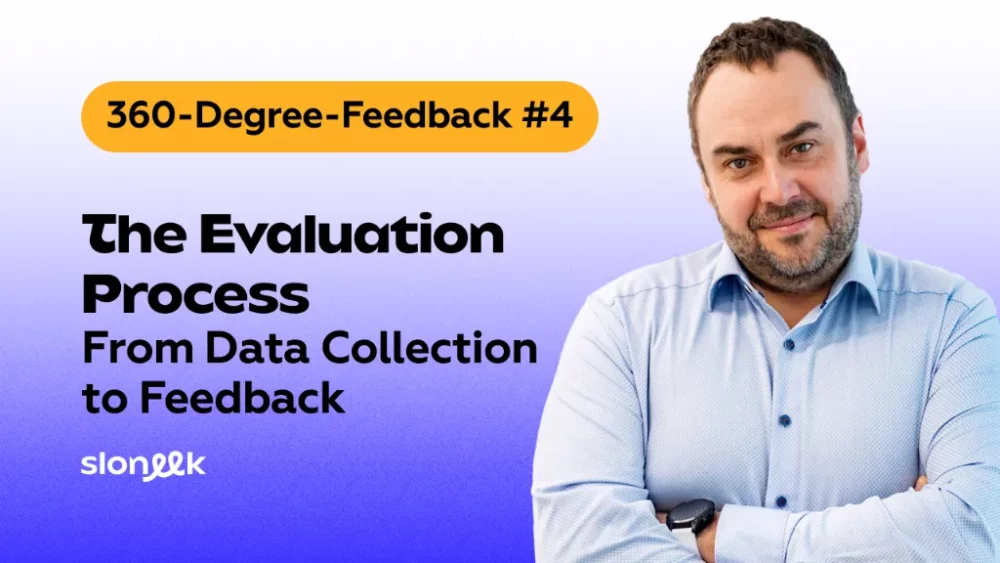360-Degree-Feedback #4: The Evaluation Process – From Data Collection to Feedback

Once your 360° feedback preparation is complete, the most exciting part begins – the evaluation itself. This is where you’ll see how well you’ve laid the groundwork. If you’ve done a solid job in the earlier phases, everything should now run smoothly. If not, you’re likely about to find out.
Managing the Process – The Devil Is in the Details
In today’s world, no one imagines running a 360-degree review using paper surveys. Online platforms are the standard – but even with digital tools, there are many details that can go wrong.
Technical Setup
Choose a platform that’s intuitive and reliable. Employees shouldn’t need training just to complete a questionnaire. Run a test with a small group beforehand to catch potential issues.
Pro tip: Always test your technology before the official launch. A platform might look great in a demo, but problems with special characters or mobile navigation might only show up during real use. If half the evaluators run into technical problems, trust in the process takes a hit. A proper pilot with a small group can uncover hidden issues and save your reputation—and your nerves.
Monitoring Progress
Set up a dashboard where you can track who has submitted their responses and who hasn’t. Plan reminder messages – typically one after a week and another three days before the deadline. Keep the tone friendly, but make the message clear.

Ensuring Anonymity – Where Pitfalls Lurk
Anonymity isn’t just a technical issue – it’s mostly about trust and communication. People need to believe that being honest won’t come back to haunt them.
Key Principles for Anonymity
- Minimum of 3 evaluators per anonymous group (e.g., peers, subordinates)
- Group-based data aggregation – never display individual results
- Clear rules on who can access which data
- Data protection that meets GDPR standards
Pro tip: Be cautious with anonymity in small teams. If there are only four people in a department, it’s nearly impossible to guarantee anonymity for three subordinates evaluating their manager—it would be obvious who said what. One solution is to combine their responses with those of peers from other teams into an “Other” category, or adjust the process to account for the specifics of small units. Always consider your organizational structure when planning for anonymity.
Data Analysis – Finding Value in the Numbers
Once the data collection is closed, the most insightful phase begins – analyzing the results. While modern software will generate clean charts and tables, the real value lies in how the data is interpreted.
Gap Analysis – The Most Valuable Insight of 360° Feedback
You’ll learn the most by comparing self-assessments with how others perceive the same individual. This is where the richest insights lie:
- Confirmed strengths: Areas where the person rates themselves positively and others agree. These are genuine strengths to build on.
- Agreed areas for improvement: Areas where the individual acknowledges shortcomings, and others confirm them. These are ideal starting points for development.
- Blind spots: Areas where the person sees themselves more positively than others do. These are often the most critical for development—because the person is unaware of them.
- Hidden strengths: Areas where others give higher ratings than the individual does. This could indicate low self-confidence or untapped potential.
Pro tip: Blind spots are the most powerful part of the process. If a manager believes they’re a great communicator but their team sees them as unapproachable, that’s a strong wake-up call. The biggest growth often comes from these surprising realizations where self-perception diverges from external feedback. Make sure to focus on these areas during the feedback conversation.
Delivering Feedback – The Most Delicate Stage of 360° Feedback
How you deliver the feedback will determine whether it becomes helpful or harmful. Receiving feedback—especially the critical kind—is emotionally demanding and requires a sensitive approach.
Who Should Lead the Feedback Session
You have a few options, each with pros and cons:
- External coach: The best option for objectivity and experience. They’re seen as neutral and skilled in handling tough conversations.
- Internal coach or HR representative: A solid alternative, assuming they have the right skills and the trust of employees. Their advantage is familiarity with the company context.
- Direct manager: This can work, but only if there’s a strong trust relationship and the manager is trained in coaching techniques. The risk is that the person receiving feedback may not feel comfortable opening up.
Structure of a Feedback Conversation
A productive session has a clear structure:
- Introduction (10 minutes): Reiterate the purpose, create a safe space, and assure confidentiality.
- Strengths (20 minutes): Start on a positive note. Talk through confirmed and hidden strengths.
- Development areas (30 minutes): Gradually shift to blind spots and opportunities for improvement. Focus on understanding—not defensiveness.
- Next steps (20 minutes): Identify 2–3 key development areas and outline possible follow-up actions together.
Psychological Aspects
Be ready for a variety of emotional responses. Some people take feedback well, others may need time to process. Common reactions include:
- Surprise or shock (especially with blind spots)
- Defensive responses or denial
- Blaming others or making excuses
- Sadness or disappointment
- Motivation to improve
The key is to stay patient, empathetic, and forward-looking. The goal isn’t to “catch” someone making mistakes—but to support their growth.
In the next part, we’ll focus on the most important thing – how to truly turn evaluation results into employee development and ensure the process doesn’t just stay on paper.




